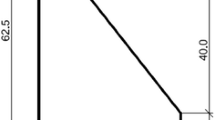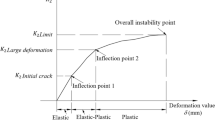Abstract
It is usually difficult to determine the actual safety factors of rock masses in an ordinary two-dimensional stability analysis if the safety factors of the different cross sections in the rock mass vary significantly. In addition to the actual slope, arch dam abutment, and the actual foundation of a high building, another example is that the different cross sections of the foundation in the monolith of a gravity dam vary significantly, just like the condition at the overflow dam in the Baise project. A three-dimensional stability analysis method based on the upper-bound theorem was employed to solve this problem. The parameters used in the analysis were obtained from geomechanics tests, as well as continuity simulations of the randomly distributed joints. Two failure patterns against sliding are analyzed. One pattern is the foundation slide along deep-seated planes which were determined by calculations. The other pattern is the foundation slide along the planes across the bottom of the high steps in the foundation pit. The results indicate that a special overflow dam monolith can be considered to be safe in case of considering the three dimensional effect. However, a key wall with a depth of 5m must be constructed at the upper side of this monolith in order to ensure the safety of the foundation.
Similar content being viewed by others
References
Kachanov L M. Foundations of the Theory of Plasticity. London: North-Holland Publication Company-Amsterdam, 1971
Chen Z Y, Wang X G, Haberfield C, et al. A three-dimensional slope stability analysis method using the upper bound theorem (Part I): Theory and Methods. International Journal of Rock Mechanics and Mining Sciences, 2001, 38(3): 369–378
Chen Z Y, Wang X G, Haberfield C, et al. A three-dimensional slope stability analysis method using the upper bound theorem (Part II): Numerical approaches, applications and extensions. International Journal of Rock Mechanics and Mining Sciences, 2001, 38(3): 379–397
Mi H L, Chen Z Y, Zhang F M, et al. The 3D limit method for slope stability analysis and applications. Rock and Soil Mechanics, 2002, 23(5): 651–653 (in Chinese)
Wang X G, Chen Z Y, Liu S W. Determination of joint persistence and shear strength parameters of rock masses by Monte Carlo method. Chinese Journal of Rock Mechanics and Engineering, 1992, 11(4): 345–355 (in Chinese)
Author information
Authors and Affiliations
Corresponding author
Additional information
Translated from Chinese Journal of Rock Mechanics and Engineering, 2006, 25(3): 533–538 [译自: 岩土力学与工程学报]
Rights and permissions
About this article
Cite this article
Xu, Q., Li, X. & Chen, Z. Three-dimensional stability analysis of the dam foundation at Baise. Front. Archit. Civ. Eng. China 1, 217–221 (2007). https://doi.org/10.1007/s11709-007-0026-y
Issue Date:
DOI: https://doi.org/10.1007/s11709-007-0026-y




